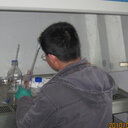Mitochondrial dysfunction in obesity-associated nonalcoholic fatty liver disease: the protective effects of pomegranate with its active component punicalagin.
کلید واژه ها
خلاصه
OBJECTIVE
Punicalagin (PU) is one of the major ellagitannins found in the pomegranate (Punica granatum), which is a popular fruit with several health benefits. So far, no studies have evaluated the effects of PU on nonalcoholic fatty liver disease (NAFLD). Our work aims at studying the effect of PU-enriched pomegranate extract (PE) on high fat diet (HFD)-induced NAFLD.
RESULTS
PE administration at a dosage of 150 mg/kg/day significantly inhibited HFD-induced hyperlipidemia and hepatic lipid deposition. As major contributors to NAFLD, increased expression of pro-inflammatory cytokines such as tumor necrosis factor-alpha, interleukins 1, 4, and 6 as well as augmented oxidative stress in hepatocytes followed by nuclear factor (erythroid-derived-2)-like 2 (Nrf2) activation were normalized through PE supplementation. In addition, PE treatment reduced uncoupling protein 2 (UCP2) expression, restored ATP content, suppressed mitochondrial protein oxidation, and improved mitochondrial complex activity in the liver. In contrast, mitochondrial content was not affected despite increased peroxisomal proliferator-activated receptor-gamma coactivator-1α (PGC-1α) and elevated expression of genes related to mitochondrial beta-oxidation after PE treatment. Finally, PU was identified as the predominant active component of PE with regard to the lowering of triglyceride and cholesterol content in HepG2 cells, and both PU- and PE-protected cells from palmitate induced mitochondrial dysfunction and insulin resistance.
METHODS
Our work presents the beneficial effects of PE on obesity-associated NAFLD and multiple risk factors. PU was proposed to be the major active component.
CONCLUSIONS
By promoting mitochondrial function, eliminating oxidative stress and inflammation, PU may be a useful nutrient for the treatment of NAFLD.






